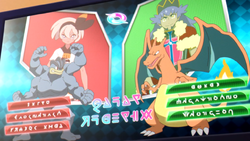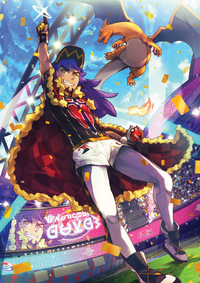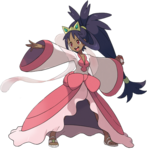Pokémon Champion: Difference between revisions
Force Fire (talk | contribs) |
(But is it speculation and assumption when the games actually tell the player that Musterd is a Fighting type trainer?) |
||
| Line 77: | Line 77: | ||
| style="background:#{{unknown color}}" | {{color2|fff|Type|Various}} | | style="background:#{{unknown color}}" | {{color2|fff|Type|Various}} | ||
| style="background:#{{unknown color}}" | {{color2|fff|Type|Various}} | | style="background:#{{unknown color}}" | {{color2|fff|Type|Various}} | ||
| style="{{roundybr|5px}}; background:#{{ | | style="{{roundybr|5px}}; background:#{{fighting color}}" | {{color2|fff|Fighting (type)|Fighting}} | ||
|} | |} | ||
Revision as of 22:42, 21 September 2020
A Pokémon League Champion (Japanese: リーグ優勝者 League Champion), normally referred to as simply Champion or Pokémon Champion (Japanese: チャンピオン Champion), is the highest known level of rank for a Pokémon Trainer. The title is also colloquially referred to as League Champ (Japanese: ポケモン リーグの ちょうてん Pokémon League's Greatest).
It usually refers to a Trainer who has completed a Pokémon League by collecting all the necessary Badges, and either winning a regional Pokémon tournament or defeating the Elite Four and the previous Champion (if there is one). Kanto and Johto share a Champion, while other regions have their own. If a Champion is defeated, they must relinquish their title to the victor; however, the victor can refuse the title, as N did in Pokémon Black and White.
Starting in Generation VII, the player, as Champion, can defend the title against challengers.
In the games

Champion is a Trainer class that first debuted in the Generation I games. It is the title held by the Trainer who last defeated the Elite Four and the previous Pokémon Champion. Each Champion is always stronger than the Elite Four members and most other Trainers, and has a party of six Pokémon to test their opponents' strength. Like Elite Four members, they employ the use of strong healing items. To challenge the Champion, Trainers must defeat all four Elite Four members without leaving the Pokémon League area, and cannot access the Pokémon League Pokémon Center and Poké Mart until after defeating the Champion or losing at any point during the challenge. If a challenger is defeated by the Champion, just like the Elite Four, they must start over.
Since in every core series game the player goes on to defeat the standing Champion (except in Alola, in which case there is no current Champion and the player battles Professor KukuiSM/HauUSUM instead), every player character is considered a Champion and subsequently entered into the Hall of Fame, along with the player's party. However, for players in games prior to Generation VII, becoming the Champion is mostly a symbolic honor, as they are unable to battle challengers or take up any other league duties; the former Champion will still remain at the Pokémon League, retaining the Trainer class Champion (in Generations I and III, Blue clearly stated his reign was over; in the Delta Episode, Zinnia teases Steven that he is the former Champion). In games prior to Pokémon Sun and Moon, the player may battle the Elite Four and the former Champion as many times as they like, and on each success will be re-entered into the Hall of Fame with whatever team was used in that challenge. In Alola, the player can instead battle the Elite Four and then take on a challenger, being able to do this as many times as they would like. In Galar, the player can host Champion tournaments, facing three Trainers per tournament. This tournament can be repeated as many times as the player wants.
In Black and White, Cynthia tells the player that once every few years, the Champions from all the regions come together and battle to find the strongest among them. In the Pokémon World Tournament in Black 2 and White 2, which takes place two years later, all the Champions the player battles in previous games participate in the Champions Tournament. This tournament does not include player characters, with the exception of Red.
In Sun, Moon, Ultra Sun, and Ultra Moon, the Pokémon League of Alola, having just been established, has no Champion. Instead, Professor Kukui (the league's founder)SM or Hau (the player's rival)USUM, stands in as the final obstacle the player must overcome before becoming the league's first Champion. In another first for the series, the player can defend their title against challenges from non-player characters. The player keeps the nominal title of Champion even if defeated. Similarly, in Pokémon: Let's Go, Pikachu! and Let's Go, Eevee!, Trace is the Champion of the Indigo League at first, but loses his title to the player. After defeating Lance in a rematch, Trace will challenge the player as a normal Pokémon Trainer in an attempt to retake the title. In Pokémon Sword and Shield, the player character can host post-game Champion tournaments, with one of the possible challengers being Leon.
In Let's Go, Pikachu! and Let's Go, Eevee!, Professor Oak reveals that originally, Trainers who defeated the Elite Four were recorded as Champions, but now Champions were going to be established as a part of the Pokémon League challenge, meaning that now a Trainer can only become a Champion by defeating the Elite Four and the current Champion. In the same games, Brock also reveals that Gym Leaders have the right to directly challenge a Champion.
Known non-player Champions in the games:
In the side games
In Pokémon Trading Card Game
In Pokémon Trading Card Game, after defeating the Grand Masters of the Pokémon Dome, the last challenge they must face is their Rival, Ronald, who beat the Grand Masters before them and obtained the four Legendary Cards. The player must defeat him to become Champion and gain control of the Legendary Cards for themselves. In the championship duel, Ronald uses the Legendary Ronald Deck, which focuses around Fire Energy, Colorless Pokémon, and the Legendary Moltres and Dragonite cards.
In Pokémon Card GB2: Here Comes Team GR!, a direct sequel to the previous game, the player, as acting Champion, pursues Team Great Rocket after their Cards are stolen.
| TCG Island | |
|---|---|
| TCG | |
| Ronald | |

| |
| Colorless | Fire |
In the anime
In the main series
In the Pokémon anime, there can only be one Pokémon Champion per region at a time, except for the Orange League. While Pokémon Trainers can freely request an informal battle from the Champion, much more popular events are the Pokémon League Conferences, which can normally be entered by Trainers with at least eight Gym Badges. The winner of these tournaments may enter the Champion League to face off the regional Elite Four members and, if successful, the League Champion.
In Alola, due to the Pokémon League being a new establishment, there was no reigning Champion for the majority of Pokémon the Series: Sun & Moon, and the winner of the region's first League Conference was directly declared the first Champion of Alola. In addition, due to the lack of Gyms in Alola, any willing Trainer is allowed to participate in its League Conference.
In the Orange League, Trainers who defeat the Orange Crew Supreme Gym Leader attain the title of Champion, but the Supreme Gym Leader is not displaced upon defeat. Winning Trainers earn the Winner's Trophy and are inducted into the Palace of Victory, but do not have to carry out any specific tasks as Champions.
In addition to gathering eight Gym Badges, the Indigo Plateau Conference is known to accept Trainers passing the Pokémon League Admissions Exam and those graduating from Pokémon Tech. There are also smaller tournaments, such as the Pokémon World Tournament Junior Cup, where the winner gets to battle the League Champion straight away. Trip and Magnus were allowed to battle Alder and Diantha, respectively, by winning such competitions.
Known Champions in the main series (including any previous ones):
A list of episodes in which a Champion (excluding Ash) appears can be found here.
In Pokémon Origins
In this series, the system for defining the Champion of the region is identical to the method seen in the Generation I games. Red and Blue won the eight Badges, and therefore the right to battle the Elite Four. Blue won against them first and became the de facto Champion, after which he faced off against Red. In the end, Red defeated him and became the new Kanto Champion.
Known Champions in Pokémon Origins:
| Name | League |
|---|---|
| Blue | Indigo League |
| Red | Indigo League |
In Pokémon Generations
Due to the format of the series, in Pokémon Generations, the subject of Champions is not addressed. In The Challenger, Blue became the Kanto Champion after defeating the Elite Four. In the last episode, Calem was shown becoming the Champion of the Kalos region. Other characters who have become Champions of their regions also appear in the series.
Known Champions in Pokémon Generations:
| Name | League |
|---|---|
| Blue | Indigo League |
| Cynthia | Sinnoh League |
| Diantha | Kalos League |
| Calem | Kalos League |
In Pokémon: Twilight Wings

Leon is the only Champion to have appeared in Pokémon: Twilight Wings. In Letter, he was seen defeating Bea in a Pokémon League battle, successfully defending his title.
In the manga
In The Electric Tale of Pikachu manga
The following are the known Champions in The Electric Tale of Pikachu:
| Name | League |
|---|---|
| Drake | Orange League |
| Ash Ketchum | Orange League |
In the Pokémon Adventures manga
In Pokémon Adventures, the Champion of each region is the winner of an elimination tournament held every three years in each region. In the Ruby & Sapphire arc, it was determined that the winners of each tournament would have to face the Elite Four, each a former champion themselves, before challenging the Champion. The main characters that took part in a Pokémon League tournament so far are Red, Blue, Green, and Black. Of the four, Red and Black both won a tournament, though only Red was formally given the title of Champion.
The following are the known Champions in the Pokémon Adventures manga:
| Name | League |
|---|---|
| Professor Oak | First Triennial Indigo League |
| Red | Ninth Triennial Indigo League |
| Steven Stone | Hoenn League |
| Wallace | Hoenn League, awarded by Steven |
| Cynthia | Sinnoh League |
| Alder | Unova League |
| Iris | Unova League |
| Diantha | Kalos League |
| Leon | Galar League |
In the Pokémon Battle Frontier manga
The following are the known Champions in Pokémon Battle Frontier:
| Name | League |
|---|---|
| Rald | Unknown |
In the Pokémon Zensho manga
The following are the known Champions in Pokémon Zensho:
| Name | League |
|---|---|
| Shigeru | Indigo League |
| Satoshi | Indigo League |
Trivia
- In French localizations, Gym Leader is translated to Champion, while Champion is translated to Maître, meaning "master".
- Diantha has the highest leveled Pokémon out of all the Champions battled the first time the Pokémon League is challenged. Her lowest level is 64, and her highest is 68.
- Although Alder has Pokémon above level 70, he is not battled as Champion until the post-credits rematch against the Pokémon League.
- Lance has the lowest leveled Pokémon out of all the Champions. His lowest level Pokémon is level 44 in Generation II, and level 46 in Generation IV. His highest is level 50 in both generations.
In other languages
Champion
| |||||||||||||||||||||||||||||||||||||||||||||||||||||||||||||||||||||||||
See also
- Pokémon Master
- Top Coordinator
- Category:Episodes in which a Champion appears
- Category:Champions' Pokémon
| Pokémon Champions | |
|---|---|
| Core series | Blue • Lance • Red • Steven • Wallace • Cynthia • Alder • Iris • Diantha • Trace • Leon • Mustard • Peony • Nemona • Geeta • Kieran • Drayton • Most player characters |
| Masters EX | Blue • Lance • Red • Steven • Cynthia • Alder • Iris • Diantha • Leon • Scottie • Bettie • Ash • Nemona • Geeta • Calem • Serena • Hop • Marnie • Bede • Leaf • Nate • Rosa • Silver • Cheren • Bianca |
| Other spin-offs |
Ronald (TCG GB) • Mark (TCG GB) • Mint (TCG GB) • Glenn (Pokkén) • Master Rosé (Duel) |
| Animated series | Lance • Cynthia • Wallace • Alder • Diantha • Steven • Ash Ketchum • Leon • Iris • Nemona • Geeta |
| Other animation | Blue (Origins) • Red (Origins) • Calem (Generations) • Celestine (PttP) • Edgar Troy (PttP) • Ava (PttP) • Boy (POKÉTOON) |
| Adventures | Professor Oak • Red • Sidney • Phoebe • Glacia • Drake • Steven • Wallace • Cynthia • Alder • Iris • Diantha • Leon • Mustard • Peony • Nemona • Geeta |
| Other manga | Shigeru (Zensho) • Satoshi (Zensho) • Rald (Battle Frontier) |

|
The Pokémon League | 
| |
|---|---|---|---|
| Participation Trainer • Battle • Gym Leaders Gyms • Badges • Referee Championship matches Elite Four • Orange League Champion League Pokémon League Conferences Indigo • Silver • Ever Grande • Lily of the Valley Vertress • Lumiose • Manalo |
Regional Pokémon Leagues Indigo • Orange* • Johto • Hoenn • Sinnoh Unova (BB) • Kalos • Alola • Galar • Paldea Areas of jurisdiction Pokémon League Reception Gate • Hall of Fame Palace of Victory • Cerulean Cave • Area Zero Others Admissions Exam • Pokémon Association PIA • World Coronation Series (Masters Eight Tournament) | ||

|
This Trainer Class article is part of Project CharacterDex, a Bulbapedia project that aims to write comprehensive articles on each character found in the Pokémon games. |













